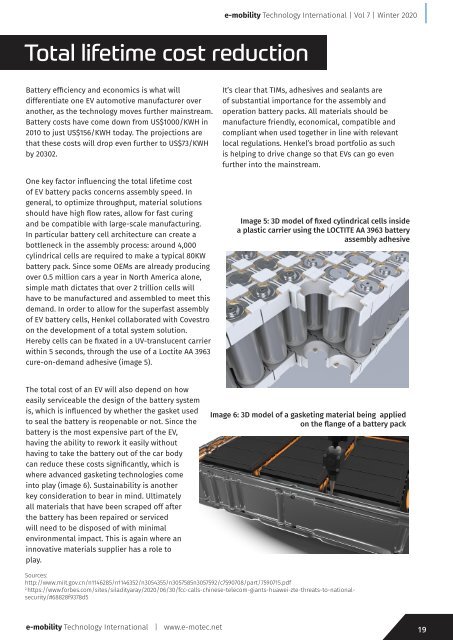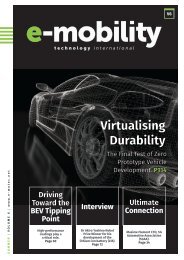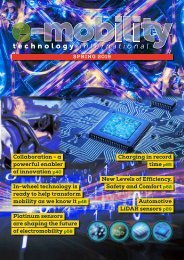E-mobility Technology Winter 2020
Electric vehicle technology news: Maintaining the flow of information for the e-mobility technology sector
Electric vehicle technology news: Maintaining the flow of information for the e-mobility technology sector
You also want an ePaper? Increase the reach of your titles
YUMPU automatically turns print PDFs into web optimized ePapers that Google loves.
e-<strong>mobility</strong> <strong>Technology</strong> International | Vol 7 | <strong>Winter</strong> <strong>2020</strong><br />
Total lifetime cost reduction<br />
Battery efficiency and economics is what will<br />
differentiate one EV automotive manufacturer over<br />
another, as the technology moves further mainstream.<br />
Battery costs have come down from US$1000/KWH in<br />
2010 to just US$156/KWH today. The projections are<br />
that these costs will drop even further to US$73/KWH<br />
by 20302.<br />
One key factor influencing the total lifetime cost<br />
of EV battery packs concerns assembly speed. In<br />
general, to optimize throughput, material solutions<br />
should have high flow rates, allow for fast curing<br />
and be compatible with large-scale manufacturing.<br />
In particular battery cell architecture can create a<br />
bottleneck in the assembly process: around 4,000<br />
cylindrical cells are required to make a typical 80KW<br />
battery pack. Since some OEMs are already producing<br />
over 0.5 million cars a year in North America alone,<br />
simple math dictates that over 2 trillion cells will<br />
have to be manufactured and assembled to meet this<br />
demand. In order to allow for the superfast assembly<br />
of EV battery cells, Henkel collaborated with Covestro<br />
on the development of a total system solution.<br />
Hereby cells can be fixated in a UV-translucent carrier<br />
within 5 seconds, through the use of a Loctite AA 3963<br />
cure-on-demand adhesive (image 5).<br />
It’s clear that TIMs, adhesives and sealants are<br />
of substantial importance for the assembly and<br />
operation battery packs. All materials should be<br />
manufacture friendly, economical, compatible and<br />
compliant when used together in line with relevant<br />
local regulations. Henkel’s broad portfolio as such<br />
is helping to drive change so that EVs can go even<br />
further into the mainstream.<br />
Image 5: 3D model of fixed cylindrical cells inside<br />
a plastic carrier using the LOCTITE AA 3963 battery<br />
assembly adhesive<br />
The total cost of an EV will also depend on how<br />
easily serviceable the design of the battery system<br />
is, which is influenced by whether the gasket used<br />
to seal the battery is reopenable or not. Since the<br />
battery is the most expensive part of the EV,<br />
having the ability to rework it easily without<br />
having to take the battery out of the car body<br />
can reduce these costs significantly, which is<br />
where advanced gasketing technologies come<br />
into play (image 6). Sustainability is another<br />
key consideration to bear in mind. Ultimately<br />
all materials that have been scraped off after<br />
the battery has been repaired or serviced<br />
will need to be disposed of with minimal<br />
environmental impact. This is again where an<br />
innovative materials supplier has a role to<br />
play.<br />
Image 6: 3D model of a gasketing material being applied<br />
on the flange of a battery pack<br />
Sources:<br />
http://www.miit.gov.cn/n1146285/n1146352/n3054355/n3057585n3057592/c7590708/part/7590715.pdf<br />
2.<br />
https://www.forbes.com/sites/siladityaray/<strong>2020</strong>/06/30/fcc-calls-chinese-telecom-giants-huawei-zte-threats-to-nationalsecurity/#68828f9378d5<br />
e-<strong>mobility</strong> <strong>Technology</strong> International | www.e-motec.net<br />
19









